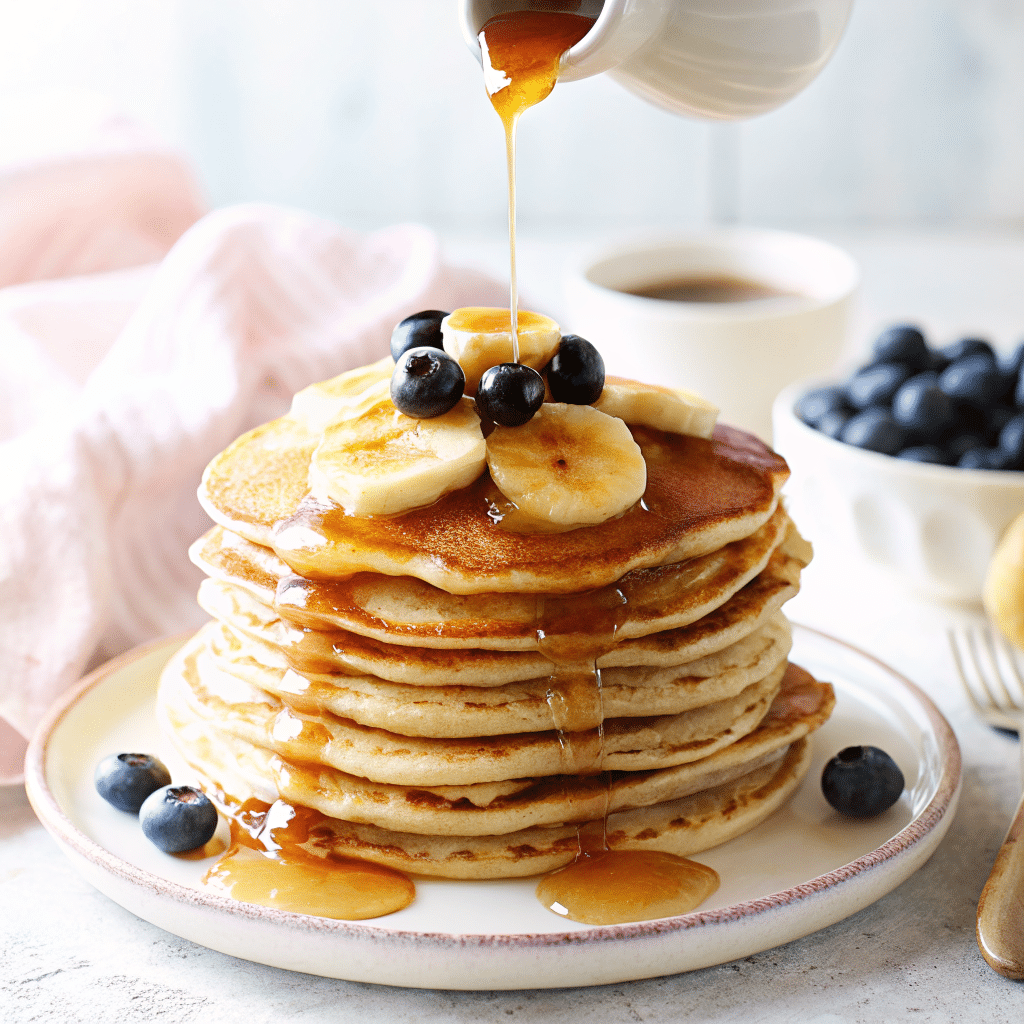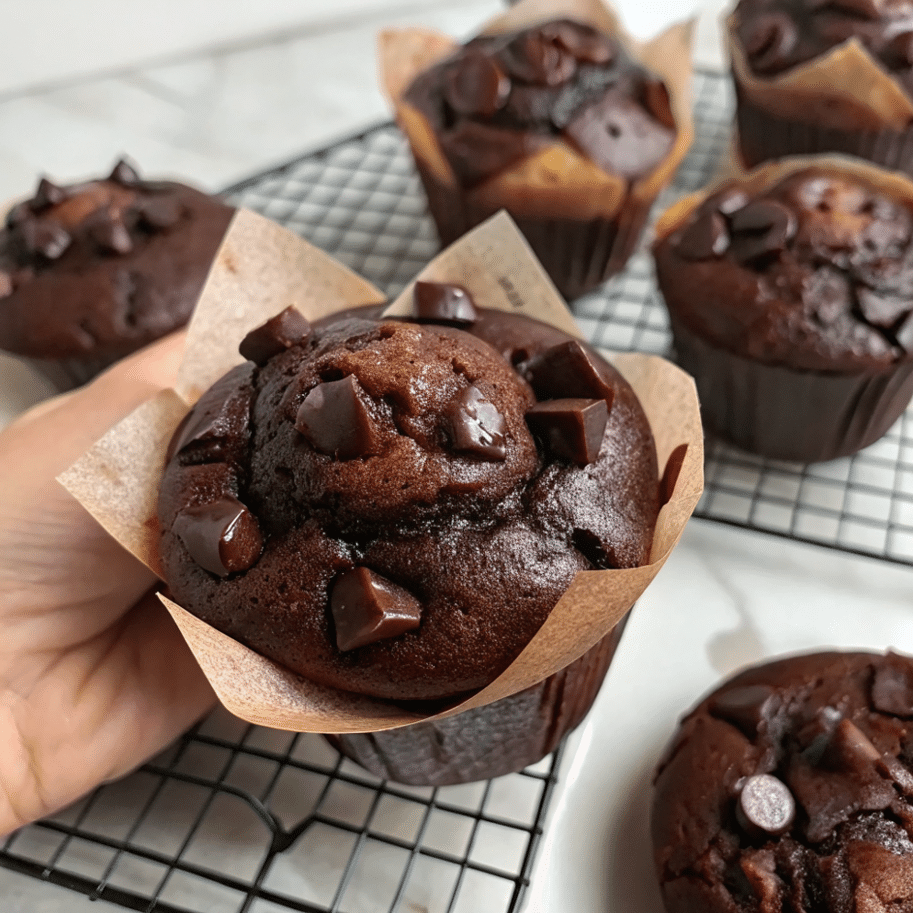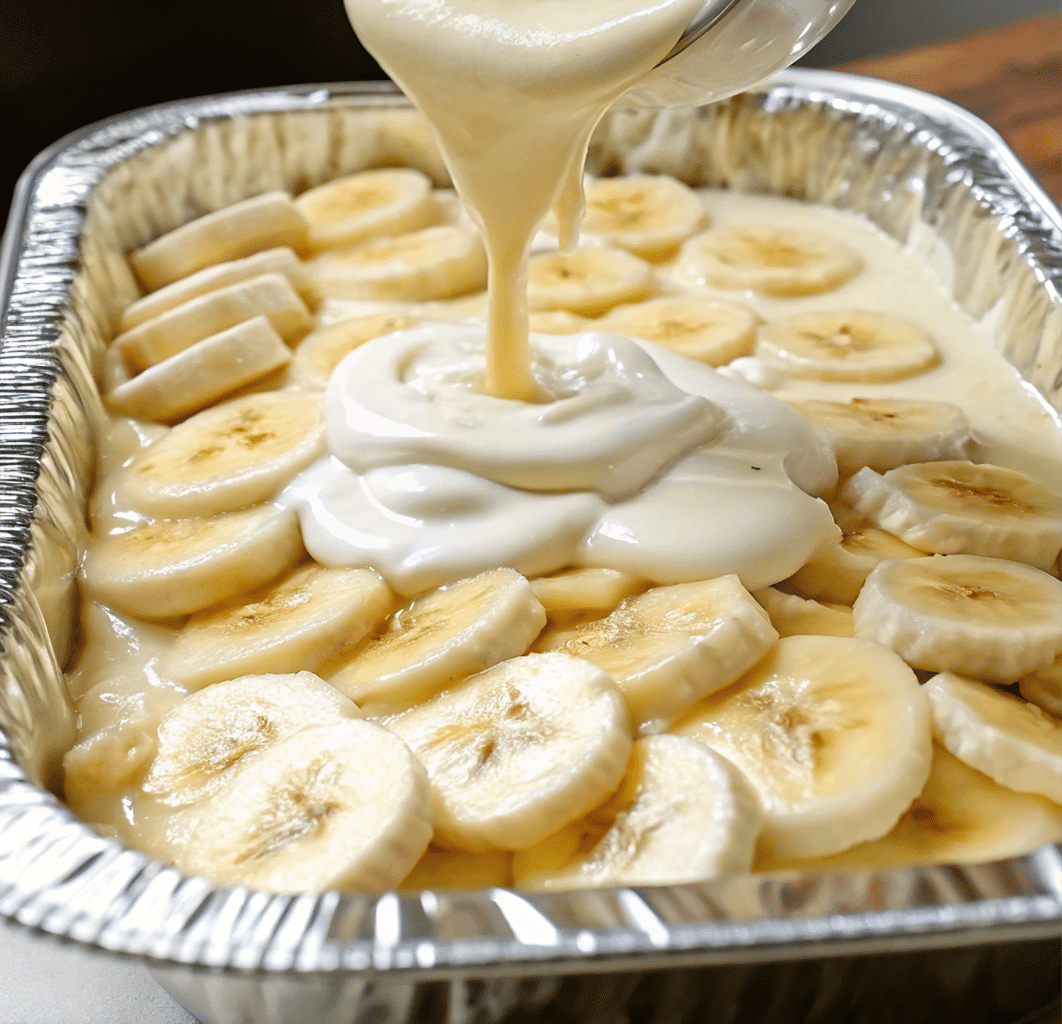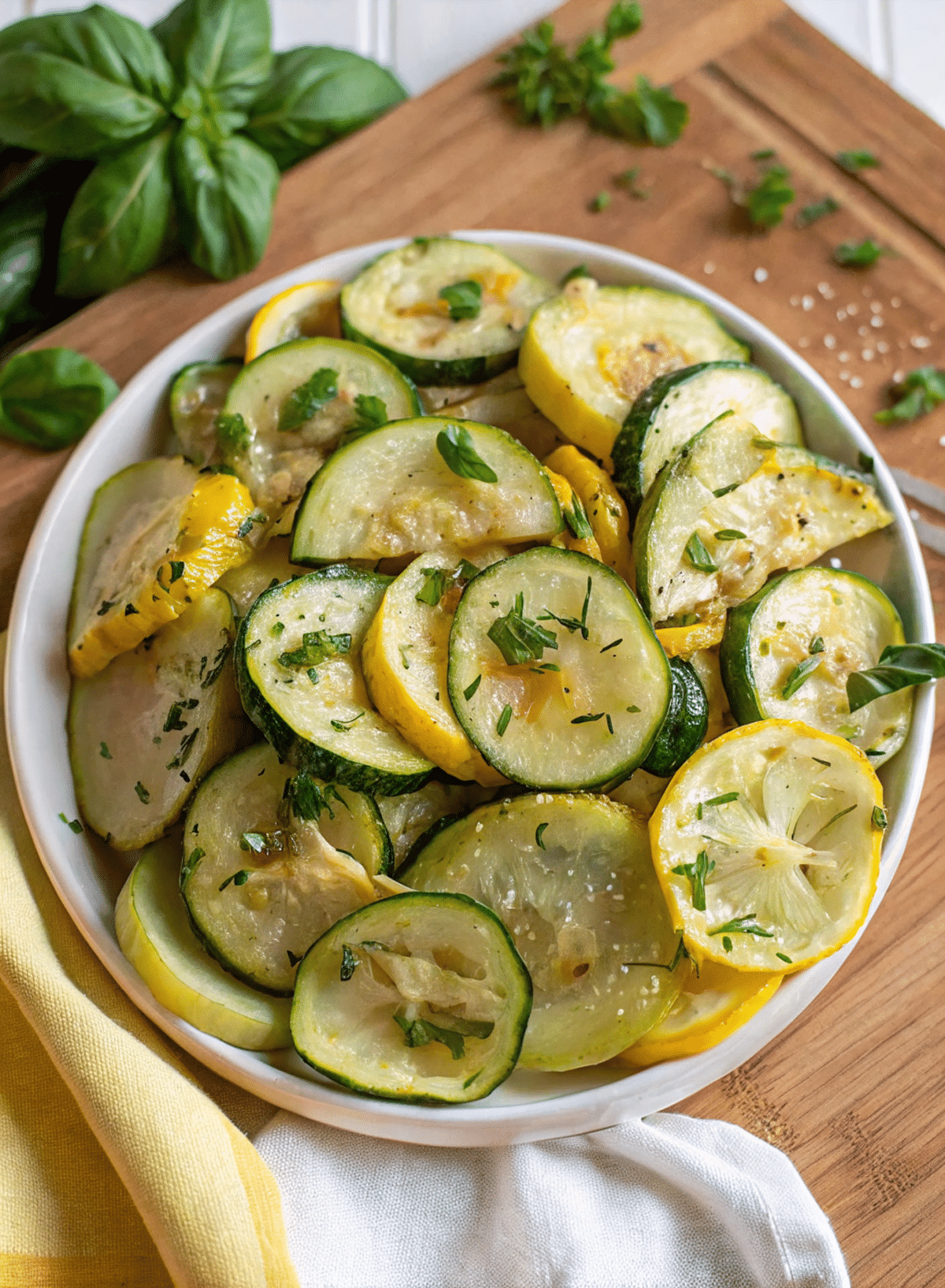This homemade hotcakes recipe is the ultimate pancake recipe you’ll ever need! They’re airy, delicious, and fabulously simple to throw together. Whether you’re craving a cozy breakfast, a weekend brunch treat, or just something soft, warm, and buttery to start the day, these hotcakes are destined to become your new go-to.

What makes these homemade hotcakes extra special? They’re made with pantry staples, don’t require any fancy equipment, and turn out golden and fluffy every single time. You’ll learn the difference between hotcakes and pancakes, get tips for flawless texture, and discover fun variations to try.
Table of Contents
Looking for inspiration? Try our banana bread latte recipe for the perfect hotcake pairing.
Let’s dive into why homemade hotcakes deserve a spot in your breakfast rotation.
What Makes Homemade Hotcakes So Special?
Understanding What a Hotcake Really Is
Hotcakes are a classic breakfast staple, often interchangeable in name with pancakes or griddle cakes. But there’s something nostalgic and comforting about calling them hotcakes—it just sounds more homemade, doesn’t it? These soft, fluffy rounds are typically thicker than crepes and cooked on a griddle or skillet until golden brown on both sides.
The term “hotcake” is more commonly used in places like the southern U.S. and even parts of Asia, especially in fast-food chains. But when you make them from scratch at home, they take on a whole new level of richness and texture you just can’t replicate from a mix or a drive-thru.
Hotcakes have a slightly crisp edge and a soft, melt-in-your-mouth center when done right. And what’s better than serving a stack with melted butter and warm syrup? Not much.
Why You Should Make Hotcakes from Scratch at Home
Let’s be real—boxed pancake mixes are easy, but they can’t beat the taste or texture of homemade hotcakes. Making them from scratch allows you to control everything: the thickness, the sweetness, and the ingredients. Whether you like yours with a hint of vanilla or prefer a touch of cinnamon, it’s all up to you.
Here’s why scratch-made hotcakes shine:
- Better Flavor: Fresh ingredients and real butter make all the difference.
- Texture Control: Mix slightly less for thicker, fluffier results.
- Fewer Additives: No preservatives or artificial flavors—just real food.
- Customizable: Add berries, chocolate chips, or even protein powder.
Want to learn how to elevate your brunch game? Discover great ideas like this zucchini bread recipe that’s just as easy and crowd-pleasing.
These reasons alone should convince anyone to skip the box and go the homemade route. And the best part? You probably have most of the ingredients already sitting in your pantry.
Homemade Hotcakes vs Pancakes – What’s the Real Difference?
Comparing Texture, Flavor, and Ingredients
At first glance, hotcakes and pancakes might seem identical. Both are golden-brown, skillet-cooked, and topped with syrup or butter. But dig a little deeper, and you’ll find some notable differences in texture, taste, and even thickness.
Texture & Thickness:
Homemade hotcakes are typically thicker and fluffier than standard pancakes. The batter is denser, often producing a cake-like bite with slightly crisp edges. Pancakes, on the other hand, lean lighter and sometimes thinner depending on the recipe.
Flavor Profile:
Hotcakes made from scratch tend to have a richer flavor thanks to real butter, vanilla, and the balanced combo of baking soda and baking powder. They also retain a subtle sweetness that doesn’t require drowning them in syrup (although we won’t judge if you do!).
Ingredient Ratios:
Both recipes use flour, eggs, milk, and leavening agents. But homemade hotcakes often call for more sugar and fat, especially when aiming for that signature golden crust and fluffy interior.
| Feature | Hotcakes | Pancakes |
|---|---|---|
| Texture | Thick & fluffy | Light & airy |
| Flavor | Rich and slightly sweet | Mild and slightly buttery |
| Cooking Surface | Griddle or skillet | Griddle or skillet |
| Common Use | Breakfast & brunch | Everyday breakfast |
If you’re making breakfast for a special occasion, hotcakes win for presentation and flavor every time. Their golden puff and soft centers look impressive but are incredibly easy to make.
Check out another comfort food favorite like our fresh Southern peach cobbler—perfect for weekends when you want a full spread.
Regional Names: Hotcakes, Pancakes, and Griddle Cakes
Terminology changes across the map. In the United States, you’ll hear pancakes most often. But in Southern kitchens, “hotcakes” is the go-to term. Meanwhile, “griddle cakes” is an old-school name still found in vintage cookbooks and diners.
Other fun variations include:
- Flapjacks: More common in the UK but sometimes used in the U.S. (though in Britain, they refer to oat bars).
- Johnnycakes: Cornmeal-based flatbreads, more savory and traditional in New England.
Regardless of what you call them, the heart of the dish remains the same—simple ingredients cooked on a hot surface, meant to be enjoyed warm and fresh.
Don’t miss our homemade yeast rolls, another old-fashioned staple perfect for breakfast or brunch spreads.
Key Ingredients for Homemade Hotcakes
Essential Pantry Staples for Hotcakes
Crafting the perfect stack of homemade hotcakes starts with simple, everyday ingredients. You don’t need anything fancy—just a few kitchen staples and a little technique.
Here’s what goes into a classic homemade hotcake recipe:
| Ingredient | Role in the Recipe |
|---|---|
| All-purpose flour | Base structure and softness |
| White sugar | Adds subtle sweetness |
| Baking powder | Provides rise and fluffiness |
| Baking soda | Works with acid (milk) for extra leavening |
| Salt | Balances the flavors |
| Eggs | Adds richness and holds everything together |
| Butter (melted) | Contributes to tenderness and flavor |
| Milk | Moisture and smooth batter consistency |
| Vanilla extract | Warm aroma and background flavor |
Good Old-Fashioned Pancakes – AllRecipes
These ingredients combine to create a batter that’s rich, balanced, and incredibly satisfying. And the best part? You probably already have them all in your pantry.
Looking for inspiration? Try this foil pack ravioli when you want a savory, no-fuss dinner after a sweet brunch.
How Ingredient Temperature Impacts Texture
One of the most overlooked aspects of making hotcakes from scratch is ingredient temperature. If your eggs or milk are too cold, they can cause melted butter to seize and clump, which messes up the batter texture.
Pro Tips:
- Let eggs and milk sit at room temperature for 15–20 minutes.
- Always melt butter right before mixing, and allow it to cool slightly.
- Whisk wet and dry ingredients separately to ensure a smooth batter.
This subtle attention to temperature keeps the batter consistent and leads to those picture-perfect, fluffy golden hotcakes every time.
Want to try more creative homemade twists? Don’t miss our fun and funky charcuterie nachos—an easy snack idea that complements your brunch table beautifully.
Step-by-Step Hotcakes Recipe Guide
Making the best homemade hotcakes doesn’t require a culinary degree—just a little care, the right ingredients, and a few tricks to get that dreamy, golden finish. Below is your easy-to-follow guide to hotcake heaven.
Prepping the Dry & Wet Ingredients Separately
Before combining everything into one glorious batter, it’s important to prepare the wet and dry ingredients in separate bowls. This step keeps your hotcakes fluffy, not tough.
Step 1: Sift the Dry Ingredients
In a large mixing bowl, sift:
- 2 cups all-purpose flour
- 4 tablespoons white sugar
- 2 teaspoons baking powder
- ½ teaspoon baking soda
- ½ teaspoon salt
Sifting helps prevent lumps and gives your hotcakes a light texture.
Step 2: Whisk the Wet Ingredients
In another bowl, whisk together:
- 2 large eggs (room temperature)
- 4 tablespoons melted unsalted butter
- 1 cup milk (room temperature)
- 1 teaspoon vanilla extract
Pro Tip: Let your wet ingredients come to room temperature so the melted butter blends smoothly instead of clumping.
Mixing and Cooking Hotcakes to Perfection
Now the magic begins—combining the wet and dry ingredients to form a silky batter.
Step 3: Combine the Mixtures
Pour the wet ingredients into the dry ingredients and gently whisk for about 1 minute. Avoid overmixing! A few small lumps are perfectly fine and will vanish during cooking.
Step 4: Preheat the Cooking Surface
- Heat a nonstick skillet or griddle over low heat for about 5 minutes to ensure even cooking.
- Add ½ tablespoon butter and raise the heat to medium-low.
Step 5: Pour and Cook the Batter
Using a ¼ cup measuring scoop:
- Ladle the batter onto the hot surface.
- Don’t overcrowd the pan—leave space between each hotcake.
- Wait for bubbles to form on the surface (about 2–4 minutes), then flip gently.
- Cook the second side for another 2–3 minutes until golden brown.
Step 6: Serve Fresh and Warm
Serve immediately, or keep warm in a 200°F oven while you cook the rest. Add your favorite toppings like:
- Whipped butter
- Maple syrup
- Fresh fruit
- Powdered sugar
Want to sip something sweet while you flip? Try our rich homemade salsa recipe as a savory side to balance the sweetness.
Pro Tips for Fluffy, Golden Homemade Hotcakes
You’ve followed the recipe—but sometimes, your hotcakes don’t come out quite as airy or golden as you’d like. Don’t worry! Even small tweaks can turn good hotcakes into absolutely perfect homemade hotcakes.
Let’s dive into what really makes them fluff up beautifully and taste just right.
Common Mistakes to Avoid While Making Hotcakes
Making hotcakes from scratch is easy, but it’s also easy to accidentally ruin the texture. Here are the most common mistakes beginners make—and how to fix them.
- Overmixing the batter
– Stirring too much develops the gluten, leading to dense, chewy cakes. Mix just until combined. - Skipping the sifting
– Sifting aerates the flour and dry ingredients. It’s essential for fluffy results. - Cooking on high heat
– High heat burns the outside before the inside is cooked. Stick with medium-low heat for even browning. - Using cold ingredients
– Cold eggs or milk cause the butter to clump in the batter. Always use room-temperature ingredients. - Flipping too early
– Don’t flip until you see bubbles on top and dry edges. This signals the right moment.
By avoiding these errors, you can dramatically improve the consistency and look of your hotcakes.
Check out this sweet breakfast idea like our not yo mama’s banana pudding if you’re looking to serve a full brunch spread.
Chef Tricks: Adjusting Consistency and Thickness
Want ultra-thick hotcakes? Or maybe a slightly thinner, diner-style version? You’re in control. Here’s how to tweak your batter to fit your style.
| Trick | What It Does |
|---|---|
| Add more flour (1 tbsp) | Thickens batter for puffier hotcakes |
| Add more milk (1–2 tbsp) | Loosens batter for thinner hotcakes |
| Let batter rest (5 min) | Allows gluten to relax; smoother texture |
| Add lemon juice (½ tsp) | Reacts with baking soda for extra rise |
Also, remember that your cooking surface matters. A heavy-duty nonstick griddle or cast-iron skillet retains heat better and promotes even cooking.
Using the right pan is like using the right shoes for a hike—everything just works better.PART 6: Easy Hotcakes Variations to Try
Once you’ve mastered the basics of homemade hotcakes, it’s time to mix things up. Whether you’re short on ingredients or just want to surprise your brunch guests with a twist, these fun variations will add excitement to your hotcake routine.
3-Ingredient Hotcakes for Busy Mornings
Don’t have time for a full recipe? No problem. These 3-ingredient hotcakes are quick, healthy-ish, and surprisingly delicious. Here’s a no-fuss version to keep in your back pocket:
3-Ingredient Hotcakes Recipe:
- 1 banana (ripe and mashed)
- 2 eggs
- ¼ cup flour or oats (optional for extra structure)
Instructions:
- Mash the banana in a bowl.
- Whisk in the eggs until smooth.
- Stir in flour/oats if desired.
- Cook over medium-low heat like traditional hotcakes.
These are perfect for kids, meal-prepping, or when your pantry’s looking empty. Add a dash of cinnamon or vanilla if you’re feeling fancy.
Tip: These hotcakes are naturally gluten-free if you skip the flour or use oat flour.
Looking for more time-saving recipes? Don’t miss our comforting mama jill’s taco bake—another crowd-pleaser with minimal prep.
Flavor Upgrades: Chocolate Chips, Fruits, and More
Now that you’ve got the basics down, try some fun flavor infusions to make your stack unforgettable.
Here are easy mix-ins and toppings to customize your homemade hotcakes:
| Flavor Add-On | Mix Into Batter or Use as Topping? |
|---|---|
| Chocolate chips | Mix into batter |
| Blueberries | Mix into batter or add on top |
| Sliced bananas | Topping |
| Chopped nuts | Topping or inside for crunch |
| Cinnamon + nutmeg | Add to dry ingredients |
| Lemon zest | Mix into batter for a citrusy twist |
| Whipped cream | Topping after serving |
| Peanut butter drizzle | After cooking |
For a savory spin, skip the sugar and add shredded cheese, green onions, or bacon crumbles to the mix. Pair with eggs for a full savory brunch plate.
These customizations make homemade hotcakes feel brand new every time you make them.
Homemade Hotcakes for Every Occasion
Homemade hotcakes aren’t just for lazy weekend mornings—they’re a versatile breakfast staple that fits nearly any occasion, from quick weekday breakfasts to impressive brunch spreads. With the right presentation and add-ons, your hotcakes can go from simple to spectacular.
Serving Ideas: Breakfast, Brunch & Beyond
Let’s explore some creative ways to serve homemade hotcakes that suit different times, guests, and moods.
| Occasion | Serving Style |
|---|---|
| Weekday Breakfast | Stack of 2 with butter and maple syrup |
| Weekend Brunch | Topped with fresh fruit and whipped cream |
| Holiday Morning | Add cinnamon, nutmeg, and spiced apples |
| Kids’ Breakfast | Use cookie cutters for fun shapes |
| Romantic Brunch | Stack with berries, powdered sugar & jam |
| Post-Workout Meal | Add protein powder or Greek yogurt inside |
Presentation Tip: Stack hotcakes high, drizzle with syrup in a zigzag pattern, and sprinkle powdered sugar for a picture-perfect plate.
These ideas help you turn your go-to hotcake recipe into something festive, fun, and fit for any day of the week.
Looking for more family-friendly brunch dishes? Don’t miss our dense bean salad with health benefits—a healthy, filling addition to a sweet breakfast.
Creative Hotcake Presentation Tips
The way you present your hotcakes can totally elevate the meal. Here are some pro tips to impress your guests (or your Instagram feed):
- Layer with yogurt or whipped cream between each cake for a parfait-style stack.
- Slice fruit thinly and fan it on top like a floral garnish.
- Use mini pancakes to create a hotcake tower (great for kids’ plates).
- Serve on a wooden cutting board for a rustic, cafe-style vibe.
- Use a squeeze bottle for syrup to create fancy drizzle patterns.
These little details make your breakfast feel special—even if it’s just for you.
Nutritional Breakdown & Healthier Substitutes
Even though homemade hotcakes are a classic comfort food, that doesn’t mean they can’t be part of a balanced diet. Whether you’re tracking calories or just looking to lighten things up a bit, this section breaks down the nutrition and offers simple ingredient swaps to make your hotcakes a little healthier without losing flavor or fluff.
Calories and Macros in a Standard Hotcake
Here’s a quick nutritional snapshot of one homemade hotcake from the recipe above:
| Nutrient | Per 1 Hotcake (approx.) |
|---|---|
| Calories | 139 kcal |
| Carbohydrates | 20g |
| Protein | 3g |
| Fat | 5g |
| Saturated Fat | 3g |
| Cholesterol | 37mg |
| Sodium | 252mg |
| Sugar | 4g |
| Fiber | 1g |
| Calcium | 73mg |
| Iron | 1mg |
Serving Size Tip: A typical breakfast includes 2–3 hotcakes, so multiply accordingly.
Compared to store-bought mixes or fast-food pancakes, homemade hotcakes are often lower in sodium and free from preservatives. But if you want to make them even better for your health goals, try these adjustments.
Swapping Ingredients for a Lighter Option
Simple swaps can make your hotcakes lighter, higher in fiber, or dairy-free—without sacrificing taste or texture.
| Original Ingredient | Healthier Substitute | Benefit |
|---|---|---|
| All-purpose flour | Whole wheat or oat flour | Adds fiber, reduces carbs |
| Whole milk | Almond, oat, or skim milk | Lowers fat and calories |
| White sugar | Coconut sugar or maple syrup (small amt) | Lower glycemic options |
| Butter (melted) | Coconut oil or mashed banana | Adds healthy fat or fiber |
| Eggs | Flax eggs (1 tbsp flax + 3 tbsp water) | Makes recipe vegan and adds omega-3s |
Even with these changes, you can still achieve the same fluffy, moist texture if you follow the tips we’ve shared earlier in this guide.
Want a drink pairing that’s light and flavorful? Try this unique pickle lemonade recipe—yes, it sounds wild, but it works!
Storing, Reheating & Freezing Homemade Hotcakes
Whether you made a double batch or just want to save a few for tomorrow, storing and reheating homemade hotcakes the right way helps maintain that perfect texture without them turning soggy or rubbery.
Best Ways to Store Leftovers Without Soggy Results
After cooling the hotcakes to room temperature, here’s how to store them properly:
| Storage Method | Duration | Tips |
|---|---|---|
| Fridge | 2–3 days | Stack with parchment paper between layers |
| Freezer | Up to 2 months | Wrap individually in foil or freezer bags |
| Room Temp | Not recommended | May lead to bacterial growth and sogginess |
Pro Tip: Let hotcakes cool completely before storing. Trapping steam leads to moisture buildup—and no one wants wet pancakes.
Use airtight containers or a sealed zip-top bag for best results.
How to Reheat Hotcakes Without Drying Them Out
Reheating is easy, but doing it right ensures your leftover hotcakes are as fluffy as when they were fresh.
Here are a few options:
| Method | Instructions |
|---|---|
| Toaster | Toast once on medium heat to crisp up the outside. |
| Microwave | Wrap in a damp paper towel and heat for 20–30 seconds. |
| Oven | Preheat to 300°F, cover hotcakes with foil, heat 8–10 mins. |
| Skillet | Warm on medium-low heat with a bit of butter for 1–2 mins. |
Avoid high heat in any method—it dries out the interior and toughens the texture.
Want a sweet treat while your hotcakes reheat? Check out our luscious creamy custard recipe, perfect for layering or topping.
Frequently Asked Questions About Homemade Hotcakes
What’s the difference between a pancake and a hotcake?
Though often used interchangeably, hotcakes tend to be thicker and sweeter with a denser texture. Pancakes are usually lighter, thinner, and may vary more in size.
What are the ingredients for pancakes made from scratch?
The base ingredients include:
Flour
Baking powder & baking soda
Eggs
Butter
Milk
Sugar
Salt
Vanilla extract
These are also the base for homemade hotcakes—just adjusted slightly in ratio for fluffiness.
How to make easy pancakes with 3 ingredients?
Try combining:
1 ripe banana
2 eggs
¼ cup oats (optional)
Mix and cook like regular hotcakes for a fast, nutritious twist.
What is the difference between a hotcake and a griddle cake?
There is no functional difference—“griddle cake” is an old-fashioned term for a pancake or hotcake, especially in Southern or Midwestern U.S. regions.
Homemade hotcakes are more than just breakfast—they’re a cozy, comforting way to start your day with warmth and flavor. From understanding what makes hotcakes unique, to mastering the recipe and experimenting with creative variations, this guide has you covered.
So the next time you crave a buttery, fluffy breakfast that brings everyone to the table, skip the boxed mix and whip up a fresh batch from scratch.
Don’t miss our cottage cheese banana bread for another wholesome and delicious breakfast idea!
Print
Homemade Hotcakes Recipe
These Fluffy Homemade Hotcakes are golden, soft, and perfectly airy. Made from simple pantry ingredients, they’re your go-to breakfast or brunch treat, ready in just 20 minutes. Top with butter, syrup, or fruit for an unforgettable stack!
- Total Time: 20 minutes
- Yield: 12 hotcakes
Ingredients
2 cups all-purpose flour
4 tbsp white sugar
2 tsp baking powder
½ tsp baking soda
½ tsp salt
2 eggs (room temperature)
4 tbsp melted butter
1 cup milk (room temperature)
1 tsp vanilla extract
Butter for cooking
Instructions
1. Sift together the flour, sugar, baking powder, baking soda, and salt in a large mixing bowl.
2. In a separate bowl, whisk together the eggs, melted butter, milk, and vanilla extract.
3. Pour the wet mixture into the dry ingredients and gently mix until just combined—do not overmix.
4. Heat a nonstick skillet or griddle over medium heat and lightly butter the surface.
5. Pour 1/4 cup of batter per hotcake onto the skillet. Cook until bubbles form on top and edges look set, about 2–3 minutes.
6. Flip and cook the second side until golden brown, about 1–2 minutes more.
7. Serve warm with butter, syrup, fruit, or your favorite toppings.
Notes
Use room-temperature milk and eggs for fluffier results.
Don’t overmix the batter—lumps are okay!
Freeze leftover hotcakes in a zip bag and reheat in the toaster or microwave.
- Prep Time: 5 minutes
- Cook Time: 15 minutes
- Category: Breakfast / Brunch
- Method: Griddled / Pan-Fried
- Cuisine: American
- Diet: Vegetarian





